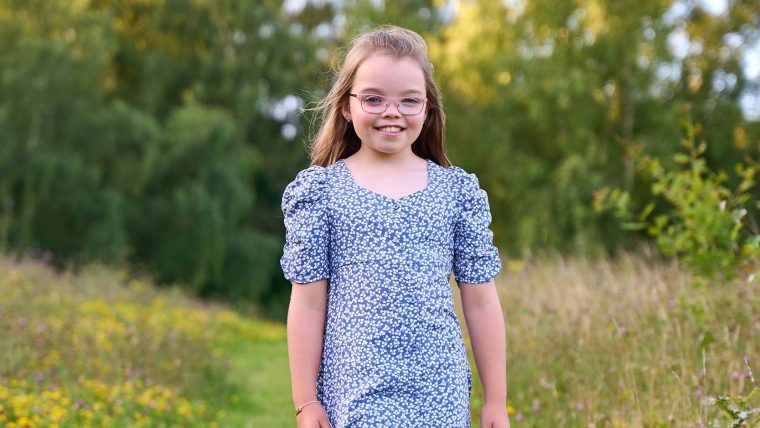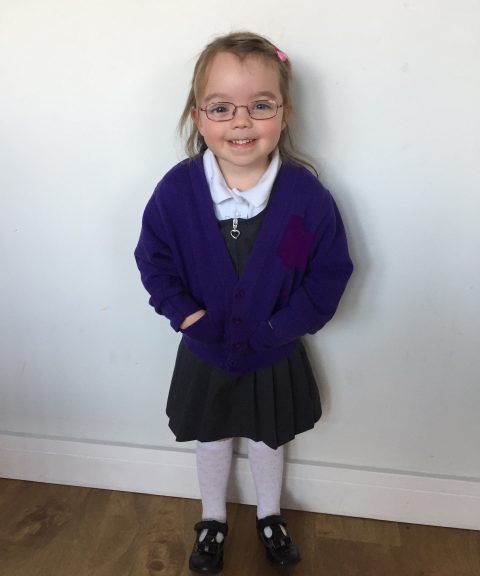Darcy’s story
9 August 2024

Just before Darcy’s 5th birthday her life took an unexpected turn and she was diagnosed with glaucoma in her right eye. Thanks to Moorfields her sight remains and 5 years on her mother shares her story.
It was discovered that Darcy had glaucoma in her right eye during a routine health checkup in her reception year at primary school.
Darcy’s mother, Katy, and father, Ben, received a notification advising an eye examination at the opticians. At first, they didn’t think much of it since Darcy never showed any symptoms or signs of serious eye issues.
What is glaucoma?
Learn more
Congenital glaucoma is also known as developmental glaucoma. This is rare but can be serious. It is usually present at birth or develops shortly after birth. It is caused by an abnormality of the eye.
Glaucoma is an eye condition where damage to the optic nerve causes sight loss. It is usually caused by the pressure inside your eye rising too high.
Your eye is full of fluid, which helps it to keep its shape and function properly. If too much fluid builds up inside the eye, the pressure rises and squeezes the optic nerve at the back of the eye.
This can cause damage to your optic nerve - a bundle of over a million nerve fibres that carry signals between your eye and your brain.
Pressure might build up in the eye when:
- fluid is stopped from draining away
- extra fluid is produced after an eye injury or infection - this is called‘secondary glaucoma’
- there is an abnormality in the shape of the eye in children - this is called‘congenital glaucoma’
Glaucoma tends to develop slowly over many years. As there is currently no cure for glaucoma, treatment focuses on early diagnosis, careful monitoring and regular treatment to help prevent further sight loss.
9 in 10
people diagnosed with glaucoma today who get the treatment they need will retain useful sight for the rest of their lives
It is not currently possible to repair the optic nerve once it has been damaged, so any vision lost to glaucoma cannot be recovered. If left untreated, glaucoma can lead to blindness.
There are usually no symptoms of a rising pressure in the eye until sight loss occurs, so regular eye tests are the best way to help spot the condition early.
They booked an appointment with a three-week wait. At that appointment, Darcy was prescribed glasses and immediately transferred to the local eye hospital.
She was put on eye drops four times a day and referred to Moorfields Eye Hospital due to extremely high eye pressure which was more than double what it should be.

Darcy Griggs when she was first prescribed glasses.

Darcy Griggs before her appointment at Moorfields on her 5th birthday.
On Darcy’s 5th birthday, she had her first appointment at Moorfields Eye Hospital with Mr Brookes.
Mr Brookes was incredibly kind, calm and made us feel we were in the safest of hands.
Katy Griggs
Mr Brookes confirmed Darcy had primary congenital glaucoma with severely damaged optic nerves in her right eye.
She had to continue with the eye drops and was booked in for trabeculectomy surgery.

Darcy Griggs post operation.
What is a trabeculectomy?
Learn more
A trabeculectomy is surgical procedure which lowers the pressure inside the eye in patients with glaucoma.
Realisation
Following the diagnosis, Darcy’s parents reviewed old photographs of their daughter. With their newfound awareness, they noticed a previously overlooked symptom of glaucoma: Darcy’s right eye appeared larger than her left.
When Darcy was a baby and toddler people would often compliment her big blue eyes. She was also sensitive to light but her parents never knew these were signs that something could be wrong.
Therefore, it was a massive shock and an incredibly worrying time for Katy and Ben when they found out.
With Darcy being so young she took it all in her stride. She never complained about any of her appointments or eye examinations even though she did and still does find it uncomfortable.
Katy Griggs
Darcy’s Treatment
There was an emergency a few weeks after the surgery when Darcy couldn’t open her eyes one morning. She travelled to London with her mother on the train; her eyes were closed for the entire journey, but she remained calm.
She was seen immediately at Moorfields A&E where it was discovered her stitches hadn’t dissolved properly. The doctor removed them right there and she could open her eyes again!

Darcy Griggs post operation.
Nine months post-surgery, Darcy’s eye pressure began to rise again. She was put on a daily eye drop.
As Darcy got older she was invited to sleepovers and her parents helped her to learn how to apply them independently. It’s a challenge for her to get the drops in accurately, but she’s learning.
Since combining the surgery with the daily eye drop, Darcy’s eye pressure has remained consistent. Her family prays this continues until there’s a treatment to reverse or cure the damage to her eye and optic nerves.
Advice for other parents
Looking back, Darcy’s parents would tell themselves to stay calm, not panic, and avoid Googling. Even though it’s easier said than done when facing devastating news and not knowing much about the disease.
They also shared that they would tell themselves there are specialised surgeons and ophthalmologists with many treatment options available.
Katy and Ben also find comfort in knowing that ongoing research means there’s hope for a cure and treatments to reverse the effects of primary congenital glaucoma in a child’s lifetime.
Hold on to this hope. We absolutely trust Mr Brookes and the team at Moorfields and the service we have received for Darcy has been first class.
Katy Griggs
Darcy’s progress after treatment

Darcy Griggs on March 2024, 5 years since the diagnosis.
Darcy is doing well since her surgery and is taking further treatment in her stride.
Five years on she has noticed that the eye drop has made her eyelashes uneven. To combat this they apply a little of the drop to her left lashes to even them out.
We are forever grateful her sight was saved when it was.
Katy Griggs
Gratitude to Moorfields
Moorfields and Mr Brookes have saved Darcy’s eyesight.
The reassurance, kindness and calm nature of the whole team, nurses, play leaders, surgeons, ophthalmologists has made us calm and they answer any questions or worries that we have, allowing us to worry less, which we are so grateful for.
Katy Griggs
Darcy’s family are deeply grateful to Moorfields Eye Charity.
We are so grateful for Moorfields Eye Charity; the money they raise goes towards vital care and research that we as patients depend upon.
Katy Griggs

